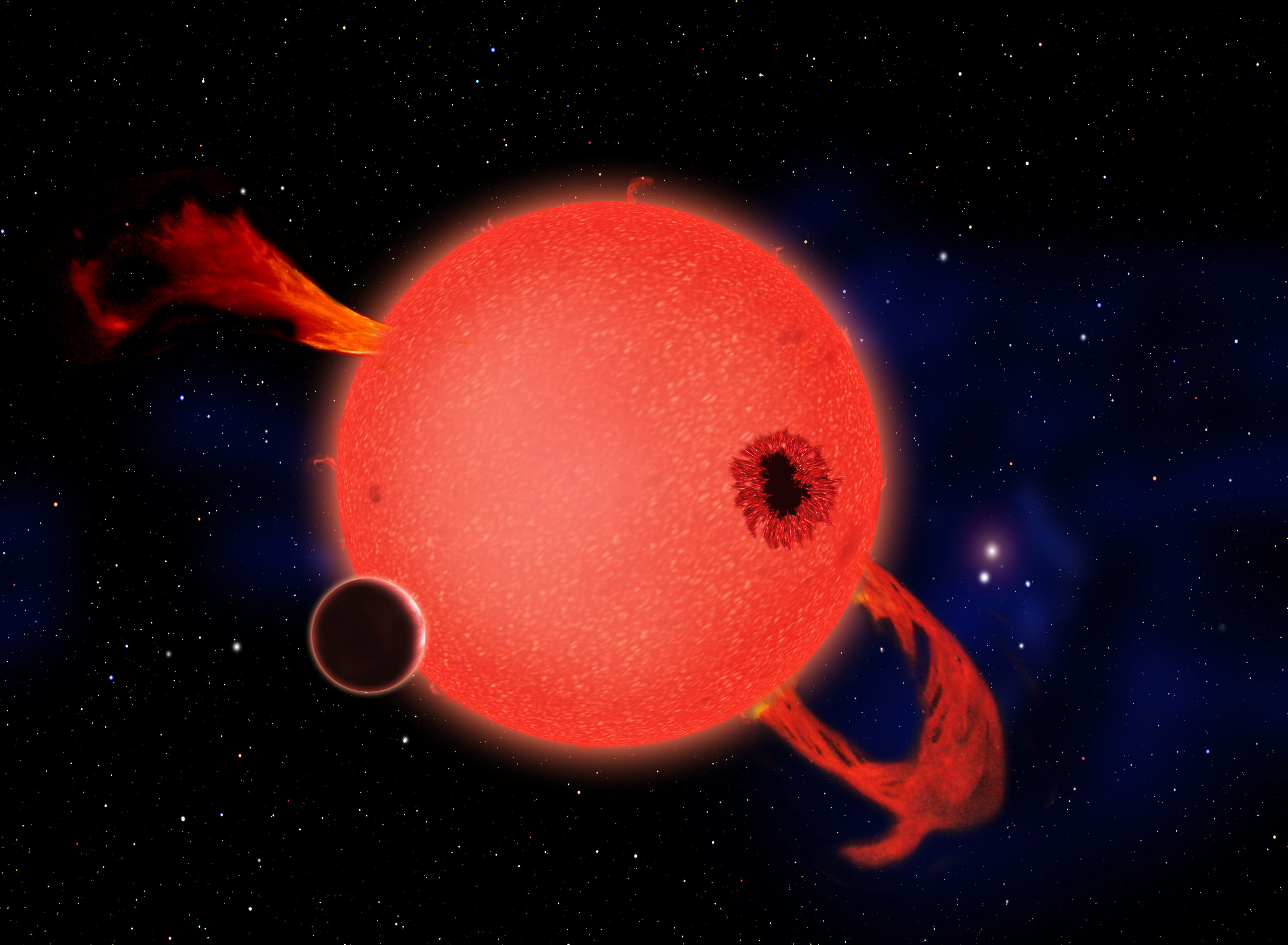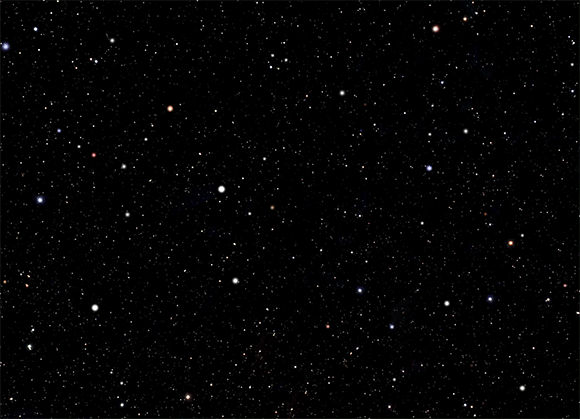Artist’s impression of a rocky planet orbiting a red dwarf. Credit: David A. Aguilar (CfA)
We may literally be surrounded by potentially habitable exoplanets, according to new research by a team from the Harvard-Smithsonian Center for Astrophysics.
Using data gathered by NASA’s exoplanet-hunting Kepler spacecraft, the CfA researchers discovered that many red dwarf stars harbor planets, and some of those planets are rocky, Earth-sized worlds. Considering that red dwarfs, albeit optically dim, are the most abundant type of stars in our galaxy, this means that even a small percentage of them being host to Earthlike exoplanets puts the total number of potentially habitable worlds very high — and some of them could be right next door.
“We thought we would have to search vast distances to find an Earth-like planet,” said CfA astronomer and the paper’s lead author Courtney Dressing. “Now we realize another Earth is probably in our own backyard, waiting to be spotted.”
And our own backyard, in cosmic terms, could mean a mere 13 light-years away.
Our solar system is surrounded by red dwarfs. You can’t see them in the night sky because they are much too dim — less than a thousandth the brightness of the Sun. But they make up 75% of the stars in the local neighborhood, and based on the Kepler data the CfA team estimates that 6% of those red dwarfs likely have an Earth-sized planet in orbit around them.
And with at least 75 billion red dwarfs scattered across the galaxy… well, you do the math.*
“We now know the rate of occurrence of habitable planets around the most common stars in our galaxy,” said co-author David Charbonneau (CfA). “That rate implies that it will be significantly easier to search for life beyond the solar system than we previously thought.”
A visualization of the “unseen” red dwarfs in the night sky. Credit: D. Aguilar & C. Pulliam (CfA) See original here.
The conditions on a planet orbiting a red dwarf wouldn’t be exactly like Earth, of course. The planet would have to orbit rather closely to its star to be within its habitable zone, and would have to have a reasonably thick atmosphere to regulate heat and protect it from stellar outbursts. But one benefit to orbiting a red dwarf is that they have very long life spans — potentially longer than the current age of the Universe! So a habitable world around a red dwarf would literally have billions of years for life to evolve, thrive and develop on it.
“We might find an Earth that’s 10 billion years old,” Charbonneau said.
The team’s findings were presented today, Feb. 6, by Dressing during a press conference at the Harvard-Smithsonian Center for Astrophysics in Cambridge, MA. The results will be published in The Astrophysical Journal. (Added 2/7/13: here’s the video of the press conference.)
CfA astronomers identified 95 planetary candidates circling red dwarf stars. Of those, three orbit within the habitable zone (marked in green) – the distance at which they should be warm enough to host liquid water on the surface. Those three planetary candidates (marked with blue dots) are 0.9, 1.4, and 1.7 times the size of Earth. Credit: C. Dressing (CfA)
Read more on the CfA news release here.
*Ok, I did the math. That’s 4,500,000,000 Earth-like exoplanets around red dwarfs alone!



I’ve heard stats that theoretically, Red Dwarfs COULD last even over 1 trillion years. Cool to imagine an ancient civilization on one of them long after they’ve lost touch with the rest of their species due to the expansion of the Universe. All alone in the completely inky blackness… Cool! (of course this would be in the remote future when the Universe IS that old…)
“And our own backyard, in cosmic terms, could mean a mere 13 light-years away.”
Okay, lets start designing a faster-than-light drive. I’ll get the Legos.
They’re likely to be tidally locked. Probably not a good thing for the development of intelligent, technology-capable life. Then there are those UV bursts red dwarfs are known for.
Read the link to the news release, they address that.
The ubiquitous images of small, thin limbed, large eyed ET’s comes to mind here. One would need such large eyes(?) for seeing in the low light level conditions of a dim red star? Of COURSE, I’m not the first to connect those dots…
But if they did evolve life and are that close, wouldn’t they have found us by now, or we them?
If a theoretical civilization hasn’t evolved enough to send radio waves towards us, nope. Or maybe they would have evolved in a different direction from what we know. Since right now the best way for us to detect other civilizations is through radio waves, if they don’t emit it, we don’t discover them. And vice versa applies.
Personal opinion – While the technology to discover exoplanets is really interesting, i think exoplanets as a topic in astronomy is very boring. I believe people get too carried away and let their imagination push the hard fact science to the side. “imagine there is an ancient civilisation on an earth like planet in the habitable zone of this star yada yada”. It’s like the old canals on Mars.
On the contrary, exoplanets are interesting and neither a given nor as expected. Mainly, they will help tremendously to understand planet evolution and the process from chemical to biological evolution here on Earth, and vice versa, by providing more or less hard constraints.
I’ll admit that the ill advised interest in the too poorly defined Fermi question and poorly thought out ROI of starflight bugs me too. They should be worked on of course, but isn’t even on the horizon on a reasonable list of priorities.
Very good press release!
“Such a world would be different from our own. Orbiting so close to its star, the planet would probably be tidally locked. However, that doesn’t prohibit life since a reasonably thick atmosphere or deep ocean could transport heat around the planet. And while young red dwarf stars emit strong flares of ultraviolet light, an atmosphere could protect life on the planet’s surface. In fact, such stresses could help life to evolve.
“You don’t need an Earth clone to have life,” said Dressing.” [My cursive.]
It hits all the main points that are usually seen as negative, my M star pet peeves:
– M star early activity can be mooted by atmosphere, and even beneficial (more energy into the habitable system).
– M star habitable planet tidal lock can be mooted by atmosphere, and even beneficial (more energy into the habitable system).
– M star habitable planets with biosphere will outlive larger stars, such as the middle age Sun.
The observed eta (Earth analogs) of ~ 5 % is consistent with early estimates, and not surprisingly ~ 3 times the current Habitable Exoplanet Catalog observation* of ~ 1.6 %.
* Under the current Habitable Zone definition. The HZ definition is undergoing a major revision, and simplification, with the improved GW climate observations. HEC eta will change Feb 18.
From similar article:
“Statistically, that means 6 percent of all red dwarfs in our galaxy should have rocky planets in the habitable zone, Dressing says.”
This one says 6% of earth-size without HZ. Math is done for earth-like.
As well as Earthlike exoplanets, there has also been consideration of Earthlike exomoons, which might obviate the problem of being tidelocked to the star, though add a possible problem of a large infrared-warm object in the sky. So red dwarf stars might have many more life-bearing bodies.
But I can’t think of a way to get an Earthlike asteroid or comet, except briefly. And an Earthlike giant planet?!
“Our solar system is surrounded by red dwarfs.” Err. I think you must mean Galaxy surely.
Nope, solar system.